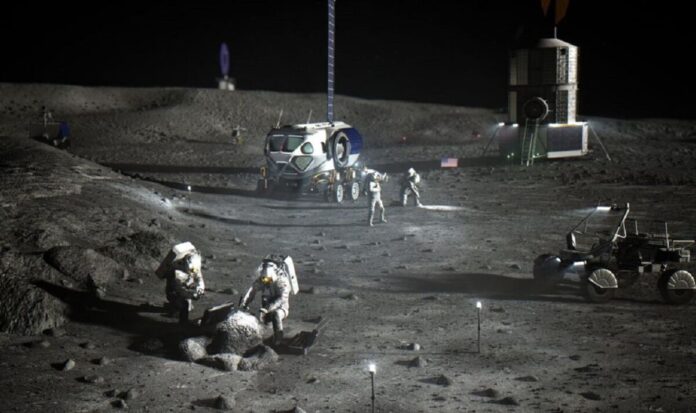As NASA’s Artemis mission looks to establish a long-term base camp on the Moon’s surface, a new study has found that such could potentially be built using bricks made from a mixture of loose lunar rocks – aka ‘regolith’ – and seawater. The bricks are capable of withstanding the extreme environments found out in space – including pressures millions of times that found on the Earth’s surface, the team report. Moreover, the fact they can be made in part using material readily available on the lunar surface means that they could help reduce the cost of construction in space.The study was undertaken by mechanical engineer Professor Ranajay Ghosh and his colleagues at the University of Central Florida (UCF).To create their bricks, the team used a combination of 3D printing and so-called binder jet technology, an additive manufacturing method which involves building up an object using alternating layers of a powder material and a liquid binding agent.In the team’s experiments, the powder material was artificial lunar regolith manufactured by the so-called Exolith laboratory at UCF.The liquid binding agent that serves to solidify the powder layers, meanwhile, was seawater. Pictured: An artist’s impression of how Artemis base camp might look (Image: NASA) The prototype bricks were made by binder jetting and then baked in an oven (Image: Warren et al. / Ceramics International)Prof. Ghosh said: ‘Binder jet technology is uniquely suitable for ceramic-like materials that are difficult to melt with a laser.’Therefore, it has great potential for regolith-based extraterrestrial manufacturing in a sustainable way.The approach, he added, could be used ‘to produce parts, components and construction structures.’The binder jetting process yields weak cylindrical bricks, dubbed ‘green parts’, which the team baked at high temperatures to produce a stronger material suitable for structural applications.READ MORE: NASA orders three more space capsules to take astronauts to the moon Pictured: Brick samples made from lunar (top) and Martian (bottom) regolith. Leftmost are ‘green’ (Image: Warren et al. / Ceramics International) Pictured: compression testing of the regolith brick samples (Image: Warren et al. / Ceramics International)Baking at low temperatures only yielded bricks that crumbled all too easily, the researchers noted.However, those that were cooked at a toasty 2,192F [1,200C] were capable of withstanding pressures of up to 250 million times that of the Earth’s atmosphere.According to Prof. Ghosh, the findings of the study highlight the potential of binder jetting and will pave the way for its use in the construction of materials and structures in space.The technique, the engineers explained, can be applied as easily to Martian regolith as lunar rocks – with the team repeating their experiments with simulated Mars rocks. DON’T MISS:Major cable cut in France just hours after Shetland incident [REPORT]British Gas unveils ‘essential’ heat pump lifeline to help slash £8000 [INSIGHT]UK facing energy crisis horror as millions of Britons trapped in debt [ANALYSIS] Baking at 1,200C left the bricks capable of withstanding extreme pressures (Image: Warren et al. / Ceramics International)The work also demonstrates how off-world structures might be built using resources found out in space, rather than transported – at great cost – with astronauts from the Earth.Prof. Ghosh said: ‘This research contributes to the ongoing debate in the space exploration community on finding the balance between in-situ extraterrestrial resource utilization versus material transported from Earth.’The further we develop techniques that utilise the abundance of regolith, the more capability we will have in establishing and expanding base camps on the Moon, Mars, and other planets in the future.’The full findings of the study were published in the journal Ceramics International.


